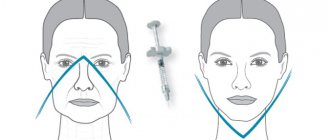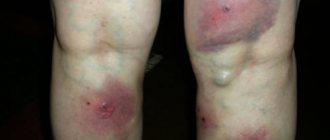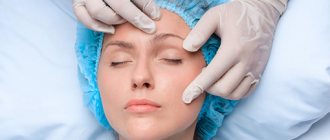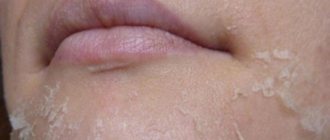How long does postoperative pain last? There is no exact answer, it all depends on the capabilities of the human body. Discomfort and even pain at the initial stage of scarring may persist constantly or occur periodically.
The suture hurts for about 2 weeks after surgery
Healing times vary from person to person, but there are averages; they depend on the location of the postoperative wound and the type of surgery:
- the suture after abdominal intervention heals for two weeks;
- wounds from laparoscopic surgery and removal of the appendix heal on the seventh day;
- healing after circumcision with phimosis (narrowing of the foreskin) lasts a little longer than two weeks;
- postpartum sutures in the perineum are scarred within 10 days;
- after a cesarean section, external sutures are removed on the sixth day;
- The stitches made in the chest area take the longest to scar, sometimes lasting a month or more.
Seams are divided into internal and external. Catgut is used to stitch together tissues inside the body (sheep intestines are used to make the material). Its advantage is its ability to dissolve; such sutures do not need to be removed.
To connect the external incisions, synthetic or natural - linen or silk - threads are used. They must be removed. In some cases, metal staples are used for stitching.
Complete growth of connective tissue in the area of the postoperative incision occurs within two to three months.
Cause of the problem
If the cosmetic suture begins to hurt several weeks or even months after surgery, you should consult a doctor. There can be quite a few reasons for this phenomenon. First of all, these are inflammatory processes associated with the addition of a bacterial infection. The appearance of unpleasant sensations depends on the characteristics of the body, susceptibility to stressful situations, and the presence of disturbances in the functioning of the immune system. An important role is played by the qualifications of the surgeons, the complexity of the intervention, the type of instruments used, the technique of applying suture material and the correctness of all manipulations.
Normally, a surgical suture should hurt for no more than 7 days; minor deviations from this value are acceptable. People's skin and muscle tissue may differ, so it is impossible to accurately determine the duration of pain.
It is necessary to consult a doctor if discomfort persists for several weeks. It is possible that errors were made during the surgical intervention, as a result of which an acute inflammatory process developed.
If the pain cannot be relieved with standard pain medications, a full examination is necessary. The operation may need to be repeated.
The stitch almost always hurts and pulls after surgery if it was a cavity operation. In such cases, not only the skin and subcutaneous tissue are dissected, but also muscle tissue and large vessels. To reduce the intensity of unpleasant sensations, the doctor prescribes special medications and procedures, the use of which requires compliance with a number of rules. During the treatment period, it is recommended to refrain from driving, especially if the person is not sure how he will behave in emergency situations. Slow walks are useful, but it is recommended to avoid climbing stairs.
Long flights and transfers adversely affect the well-being of even a healthy person, and in the postoperative period they can lead to serious consequences. You cannot lift weights weighing more than 3 kg, or carry children or animals. After improving the general condition of the body, you can introduce light physical activity into your daily routine. You should avoid visiting bathhouses, saunas and solariums.
Daily care of the postoperative scar is necessary. The seam must be cleaned of dirt and crusts, treated with antiseptic solutions and covered with a protective bandage. Slight redness of the affected area is considered normal. You should not peel off the patch yourself; after a certain period of time it will come off on its own. Lumps and a feeling of tightness in the scar area may appear. There is no need to worry, these are natural sensations that accompany the healing process.
Exposure to direct sunlight can disrupt the scarring process, so it is recommended to wear covered clothing in the first months after surgery. In the first days after surgery, blood spots may be found on the bandage. If they are small in size, there is no need to worry. If the scar bleeds heavily, you should immediately consult a doctor.
Do not use any external agents without a doctor's permission. You can shower no earlier than 3 days after surgery. Over the course of several months, the crust comes off the scar and it becomes less hard and bright. Why does the stitch hurt after a cesarean section? This question worries many young mothers who have undergone this operation.
Causes of suture pain after cesarean section
This operation can be performed in several ways. Corporal caesarean section is prescribed for the development of massive bleeding during childbirth. This method is used quite rarely, since it leaves a large scar that expands over time. Corporal surgery - dissection of tissue from the midline of the abdomen to the pubis. A longitudinal incision is made on the wall of the uterus. In the absence of complications, Pfannenstiel laparotomy is used. The incision runs along the suprapubic fold.
Unlike a longitudinal one, a transverse incision becomes less noticeable over time and postoperative pain is less intense, which is the main advantage of this operation. The operation is completed with the application of absorbable suture material. During a corporal caesarean section, the postoperative scar must be highly durable, so a cosmetic suture is not used in this case. In the first days after the operation, the patient feels acute pain associated with the presence of incisions in the uterus and abdominal wall. It is practically no different from that of other surgical interventions.
What is a postoperative suture?
Any surgical intervention is accompanied by dissection of the skin of the human body or mucous membranes to create access to an organ or cavity for the purpose of diagnosis or treatment. The final stage of the operation is to connect the cut tissues using suture material - this is the postoperative suture.
For each operation, the surgeon selects the optimal suture and the materials from which it is made, which allows the incision to be securely and accurately sutured. The doctor’s choice is influenced by the depth and extent of the wound, as well as the degree of separation of the edges. Surgical sutures differ from each other in the timing of application, the use of different materials, and the methods of applying stitches. The main classification and characteristics are presented in the table.
| Classification | Characteristic |
| By type of seam |
|
| According to its ability to dissolve in tissues |
|
| Depending on the timing of application |
|
| By material type |
|
| By application method |
|
Departure is paid separately - 300 rubles
Request a call
Call any time of the day:
+7 (499) 455-08-05
Also, the seams can be single-row or double-row, turned in and out, with different knots. It is quite difficult for a person without special knowledge to understand all the intricacies, so removing postoperative sutures at home is only possible with the involvement of medical professionals.
Drugs
In the postoperative period, the doctor prescribes antibacterial and painkillers. On the first day, narcotic analgesics are used: Tramadol, Morphine, Omnopon. Over time, they are replaced with weaker agents, the action of which is aimed at reducing the intensity of pain. It is the pain of the suture after surgery that is the reason why women fear a cesarean section. Unpleasant sensations disappear quickly, you just need to take all the medications prescribed by your doctor and properly care for the suture.
Sometimes the stitches after surgery bother you for a long time. What are the reasons and how to get rid of painful sensations.
For any person, surgery is a serious step. The postoperative period that follows is no less complex and dangerous. Sometimes it lasts for a long time. If the stitch hurts for a long period after surgery, you need to see a doctor.
How do doctors remove stitches?
A doctor or nurse can remove stitches after surgery. A preliminary examination is carried out, and in some circumstances the period of wearing stitches may be extended. There are also cases, for example, with a long cut, when the stitches at the first stage are not removed all, but after one. This is done to reduce the risk of wound dehiscence. The remaining stitches are removed after a few days.
The procedure is carried out using sterile instruments to avoid inflammation and infection of the wound. The seam is pre-treated with antiseptics.
Suture removal includes the following steps:
1. The doctor or nurse, using anatomical tweezers, grasps and lifts the suture knot and carefully cuts the thread.
2. Next, carefully, without applying excessive force, the specialist pulls out the thread. There are several important rules at this point: you cannot pull the knot through the skin, and the thread located on the surface should not get under the skin when removed.
3. The doctor performs the above steps for all remaining nodes.
4. If the sutures are placed in several rows, remove them one by one.
5. At the end of the procedure, the doctor carefully examines the skin for any remaining suture material, then re-disinfects the incision site and applies a bandage with antibacterial ointment.
Departure is paid separately - 300 rubles
Request a call
Call any time of the day:
+7 (499) 455-08-05
The procedure is different if a different suturing technique is used or metal staples are used. The correct technique for removing sutures and following all antiseptic rules prevents complications.
Causes of pain
Unpleasant sensations and pain at the suture site can occur after any surgical intervention. The nerve fibers of the soft tissues are damaged, and the sensitivity of the injured part of the body increases. This process is natural and understandable - damaged tissues grow together, sutures heal.
But if over time the pain only intensifies, and the temperature periodically rises, this is a reason to seek help. Internal tissue suppuration may occur even if the external incision is closed.
Why does the suture hurt after surgery and how long will it take to heal? This directly depends on the complexity and duration of the operation, the qualifications of the surgeon, and the cleanliness of the instruments and materials used. Pain may occur for the following reasons:
- the seam area has been rubbed by clothing;
- formation of adhesions, hernias;
- inflammation at the site of the ligature - the body rejects the threads;
- divergence of internal seams due to muscle tension;
- aching pain, as a reaction to a sudden change in weather conditions.
Duration of pain
How long can a stitch hurt? Unpleasant sensations can be constant or occur periodically, for example, with muscle tension, coughing, sneezing. Pain and swelling around the wound may be accompanied by other symptoms. The stitches may leak fluid or pus. Characterized by general weakness and lethargy, sleep and appetite disturbances, decreased concentration.
It is impossible to say exactly how long the stitch will hurt after surgery. Everyone's deadlines are different. Typically, pain in the suture area lasts a little more than a week, depending on the characteristics of the body. The average healing time for surgical wounds depends on their location:
- for wounds from abdominal surgery - about two weeks;
- sutures after appendicitis and laparoscopy are tightened after 7 days;
- circumcision involves a regeneration period of up to 15 days;
- The sutures in the chest area take a long time to heal;
- healing of the postpartum suture occurs within 10 days;
- external sutures after cesarean section are removed on the 6th day.
Seams can be internal and external. The first ones are applied using catgut made from sheep intestines. They dissolve independently in the body. The outer ones are more durable; they are made with natural (silk, linen) or synthetic threads. After a certain time, such sutures are removed. Metal staples are also used. It should be understood that the connective tissue fully grows within 2-3 months.
When to remove stitches
Recently, special absorbable threads have been used, which over time are independently removed from the human body. The choice of suture material is influenced by the time during which the connecting effect should remain. If it is impossible to use absorbable threads, then regular ones are used, which the doctor removes after the wound has healed. As a rule, in medicine there are certain periods of time between the application and removal of sutures:
- on the abdominal cavity - 7-10 days;
- on the chest - 10-14 days;
- on the head/face/neck - 6-7 days;
- shins/feet – 10-14 days;
- with laparoscopy - 6-14 days;
- after caesarean section - 8-10 days.
It is impossible to determine exactly in advance when and how to carry out the procedure, because the ability of tissues to regenerate is an individual process, on which the timing of suture removal largely depends. The duration of wearing sutures can also be affected by old age, a weakened body, concomitant diseases in the patient, suppuration or infection of the wound.
Order suture removal at home
Promotion
Included in the price:
- Antiseptic treatment
- Removing suture material (suture removal)
- Secondary treatment with antiseptic
- Applying healing ointment
- Applying a bandage
- Necessary materials and preparations
More information about the service
The main indicator that it is time to remove the stitches is the healing of the wound. This can be determined by several signs:
- tightly fused edges of the wound;
- absence of inflammation, redness and pain in the suture area.
It is worth keeping in mind that a procedure performed too early leads to sutures coming apart, and if removal is delayed, there is a risk of wound suppuration and threads growing into the skin. In any case, whether the patient has sutures removed at home or in the hospital, consultation with a surgeon is necessary. Only an experienced specialist is able to assess wound healing, thereby minimizing possible complications.
Painful stitches after cesarean section
After the intervention, the wound is present on the skin, fatty tissue, muscles, and uterine wall. Women often complain that... Pain makes it difficult for a woman to recover and care for her baby.
The pain is sharp, does not subside, lasts two days, is relieved with medications. It gradually decreases, discomfort and itching can be observed for about two weeks. The sensitivity of the skin is impaired, and numbness of the abdomen in the area of the incision may occur. Symptoms disappear completely within six months. Regular inspection of the condition of the seam by a specialist is necessary.
When the suture hurts after a cesarean section for a long time, or complications arise - suture dehiscence, swelling, redness, fever, purulent discharge - a visit to the doctor is required. Sometimes the consequences take a long time to make themselves felt. In a few years, fistulas may form from the suture material. The scar thickens, its color changes, and the fistulas periodically fester.
What to do if the suture oozes and hurts after a cesarean section?
In the first days after a cesarean section, the woman is under the supervision of medical personnel in the maternity hospital.
To reduce pain, sedatives and painkillers are prescribed. If the suture does not heal well and oozes, special ointments and preparations are prescribed that improve skin regeneration, accelerate the resorption of sutures and prevent the release of fluid from them. In order for the seam to regenerate faster, you should not overuse moisturizing ointments. It is generally recommended to use drying and disinfecting agents, such as iodine, potassium permanganate, and brilliant green. In addition, the suture after a cesarean section should be treated with vitamin E. This treatment promotes good nutrition of the skin and accelerates the healing process. If the suture begins to fester, in addition to treatment with antiseptics, antibacterial ointments and oral antibiotics are prescribed.
Usually, after discharge from the maternity hospital, a woman should no longer be bothered by severe pain. If the suture after a cesarean section hurts for a long time, or there is fluid discharge from it, this should be brought to the attention of the attending physician or gynecologist.
In medical practice, there have also been cases where pain in the suture area after a cesarean section occurred several years later. So-called ligature fistulas can form in the form of inflamed seals. This is due to the rejection of the suture material by the woman’s body. In such cases, repeated surgery may be required to excise the fistula and prevent infection. Therefore, if a woman notices pain in the suture area even after a long time, she should immediately consult a doctor for timely medical assistance.
Features of seam care
Restoration of the skin and healing of sutures depends on the body’s immunity and the skin’s ability to regenerate. After laparoscopy, small incisions remain; they are not sutured, but glued together with adhesive tape. A postoperative scar can be large, have drainage, take a long time to heal, and require high-quality care.
Treatment of the wound in a hospital is carried out by medical staff. After discharge, the patient takes care of the suture at home, in accordance with the doctor’s recommendations. In order for the seam to tighten quickly and well, you need to:
- follow doctor's orders;
- maintain personal hygiene;
- adequate sleep is necessary;
- proper nutrition.
For the first 10 days it is not recommended to take a bath; you can wash in the shower. The scar is carefully dried with a bandage, then treated with an antiseptic. Iodine, brilliant green, Fukortsin, alcohol and others are suitable. You should not use cotton wool for processing, as fibers may remain on the seams. A prolonged seam can be lubricated with sea buckthorn oil or Levomekol ointment. If the wound is clean and dry, a bandage is not needed.
Circumcision is the most frequently performed procedure by urologists. After the operation, the patient independently makes dressings with Furacilin solution at home. Before removing, the bandage must be soaked in hydrogen peroxide so as not to injure the wounds. When the bandage is easily removed, the dressings are stopped. The wounds can be lubricated with brilliant green or antiseptic ointment applied. To avoid complications and pain in postoperative sutures, circumcision should be performed by an experienced and qualified urologist.
How to get rid of pain
After any violation of the integrity of the skin, scars form. Sometimes they cause not only physical pain, but also emotional discomfort, being a cosmetic defect. In the affected area, connective tissue cannot replace healthy skin, since it does not have sebaceous and sweat glands. Changes also occur in the nerve endings located in the skin. Painful formations – neuromas – appear in the thickness of the suture.
Neuropathic pain syndrome occurs. Pain occurs not only in the scar, but also around it. It can be burning, shooting, and can get worse after coughing or sneezing. In addition to analgesics, hormonal drugs and antidepressants are used. Patients do not tolerate physiotherapeutic procedures well, since the suture is very sensitive to touch. If drug therapy does not have an effect, the scars are removed surgically.
Over time, the seam fades and becomes less noticeable. To restore skin, food must contain enough protein, vitamins and microelements. In summer, the seam should be protected from sunlight; thin, delicate skin can get burned. There are drugs in pharmacies that promote the resorption of sutures. The scars can be massaged daily, while rubbing in vitamin E or “Star” balm.
Why does the pain persist after surgery? How to relieve pain after surgery? What are the causes of pain after surgery? – in this article we will help you find answers to these and similar questions, namely, we will talk about an effective and safe method of treating pain after surgery, the causes and symptoms of this disease, as well as the most popular myths associated with it.
what is pain after surgery
Pain after surgery is an excruciating or unpleasant sensation experienced by a patient who has undergone surgery. Pain is felt not only in the suture area or adjacent to it, but also in distant areas.
The nature of the pain depends on the disease for which the operation was performed. Most often, such pain develops after operations to remove a herniated intervertebral disc, inguinal hernia, gall bladder, joint replacement, gynecological operations, as well as after cesarean section, injuries and burns.
What can you do if your stitches hurt after surgery?
After the operation, the patient is prescribed painkillers. After heavy operations, in the first two or three days these are narcotic substances. But don’t worry, because they are not addictive, but only relieve pain.
In recent years, more and more women are giving birth by caesarean section.
This technique allows for delivery in cases where natural birth is impossible or contraindicated.
However, like any operation, a cesarean section can lead to negative consequences or complications.
causes and symptoms of pain after surgery
Pain after surgery to remove a herniated disc has special manifestations: lower back pain may disappear, but appear after some time; The foot may begin to go numb, the pain in the leg may intensify, the entire leg may tingle and a feeling of “crawling goosebumps” may appear, and it is often painful to lean on the leg. Relative relief occurs only in bed in a certain position (on your side, lying on your stomach, etc.).
Pain after other types of operations is similar in its manifestations: pain and stiffness when moving, muscle spasms, aching pain in the suture area.
The reasons for the development of pain after surgery to remove a herniated intervertebral disc, both in the immediate and late postoperative periods, are:
- narrowing of the spinal canal from scars and stagnation of venous blood, compression of the spinal cord and nerves;
- progression of osteochondrosis, the appearance of new hernias in adjacent intervertebral discs;
- inflammation in the spinal canal of the spine;
- inflammation of the intervertebral joints (arthrosis);
- spasm of the muscles of the lower back and pelvis in the area of the surgical suture;
- incomplete removal of the hernia, which continues to put pressure on the nerve root;
- damage to nerve trunks, leading to numbness and dysfunction of the limb.
After other operations, pain occurs for the following reasons:
- deep and superficial postoperative scars that compress painful nerve endings, blood vessels and nerve trunks;
- muscle spasm in the area of the surgical suture;
- inflammatory process in the soft tissues around the surgical suture;
- disruption of metabolic processes in the soft tissues around the surgical suture;
- formation of adhesions between the suture and the membranes of internal organs;
- venous and lymphatic edema in the extremities.
pain after surgery: myths and reality
Today, there are a number of misconceptions about the treatment of pain after surgery, generated mainly by the lack of objective information about the proposed therapy in the person facing this problem. We will try to clarify this issue and debunk the most popular myths.
After surgery, only the skin scar hurts
Most often, it is not the skin scar that hurts, but other tissues that were damaged by surgery. Under the skin, fascia, muscles, ligaments may ache, and scar lumps may form, which, with proper treatment, soften or dissolve.
Massage is effective for postoperative pain
Massage does improve blood circulation in the operated area, but deep postoperative scars do not resolve from massage. Or the massage must be harsh and long-lasting for relief to occur. Injection drug treatment or plasma therapy, which produce an effect within the next few days from the start of treatment, is much more effective.
Folk remedies are effective for pain after surgery
Fresh postoperative pain can be relieved with folk remedies (ointments, compresses). The more time has passed since the operation, the more difficult it is to obtain any effect.
If your back hurts after surgery on a vertebral hernia, then the hernia came out again or in another place
It may not be the hernia that hurts, but the scars after surgery, which put pressure on the blood vessels and nerve endings.
Postoperative scars are safe, although they hurt, but the pain will gradually go away
Continued or increasing pain after surgery is a sign that tissue repair is a scarring process and new tissue is being drawn into the scar. It is important to stop this process, and soften and dissolve scars, because with age there is a tendency for scarring and pain to increase.
As can be seen from the examples described above, an objective look at the problem of pain after surgery from the point of view of ways to solve it helps a person who has been diagnosed with this disease to promptly and thoughtfully approach the choice of an effective and safe treatment method.
about our treatment of pain after surgery
Our treatment of postoperative pain differs from the standard in its systematic approach.
The fundamental difference between the academic approach of conventional treatment and the systemic approach of our treatment is that academic medicine diagnoses and eliminates the symptom, and systemic medicine deals with the cause of the development of postoperative pain.
Pain after surgery usually develops from a combination of causes. Effective treatment requires elimination of each of them. If the cause of the development of the disease for which the operation was performed was one and eliminated surgically, then the body recovers and the pain goes away. This operation is considered “successful”. If there was a combination of reasons and only one was eliminated during the operation, then pain after the operation develops due to the remaining reasons, to which another one is added - a postoperative suture. Such an operation is considered “unsuccessful.”
What a set of causes is can be explained using the example of postoperative pain due to the removal of a herniated intervertebral disc.
Before surgery, the back pain experienced by a person diagnosed with a herniated disc appears from compression of a nerve by a prolapsed hernia. Pain can also be associated with muscle spasms, inflammatory processes in the intervertebral joints, from the incorrect structure of this part of the spine, or from a previous injury to the soft tissues of this area (muscles, ligaments).
After the operation, an additional reason for increased pain appears - a postoperative scar - tissue compaction during the fusion of the postoperative suture. Seals in the form of scars form not only on the skin, but also in deep tissues (muscles, ligaments, in some cases, tissues of internal organs).
Post-operative scars put pressure on the nerves, exacerbating the pain.
Thus, to the set of reasons existing before the operation, one more is added - postoperative scars. Over time, the pain increases, the function of movement worsens.
To treat postoperative pain, we prescribe the patient a course of subcutaneous microinjections with absorbable drugs to eliminate excessive suture seals and adhesions in soft tissues, a course of muscle mesotherapy to relieve spasms and triggers (compressions) in the muscles, a course of osteopathy to restore movement function, a course of nutraceuticals for better regeneration tissues and relieve inflammation in intervertebral joints.
Relief occurs on the first day after starting treatment. Over the next month, the pain decreases significantly. Within a few months, the person returns to his normal lifestyle.
Treatment of fibroadenoma
There is no drug treatment for benign neoplasms; the use of hormonal drugs helps balance the production of sex hormones, but does not resolve the formed breast fibroadenoma.
With absolute confidence in the benign nature, which a biopsy of the tumor node can prove, and its small size, observation with periodic X-ray monitoring is possible, but regular irradiation will not add health to the body and harms the tissue of the mammary glands.
Suspicious for breast carcinoma and therefore subject to surgical removal:
- a rapidly growing tumor that has increased in size over the last 3 months of observation;
- neoplasm in a woman after 35 years of age;
- a tumor in a woman from a family with a history of breast, ovarian and colon cancer.
Objective evidence of a high probability of fibroadenoma obtained during the examination, and primarily a biopsy, will allow the surgeon to perform a more aesthetic operation with a minimal tissue incision.
The operation is called sectoral resection or lumpectomy ; local anesthesia without general anesthesia is acceptable. The skin is incised over the projection of the tumor node, and today they resort to crescents, rather than a radial incision. Radial incisions are unesthetic, take longer to heal and can deform the breast. The best cosmetic results are obtained by skin incisions along the edge of the nipple and along the fold under the breast.
Only the tumor is excised from the glandular tissue, which is immediately sent for urgent histological examination so as not to miss cancer. The surgeon tries not to damage the large ducts, so as not to complicate subsequent breastfeeding. The integrity of the gland tissue is restored with an internal suture, and cosmetic intradermal sutures are applied to the skin.
We begin treatment for pain after surgery
Treatment of pain after surgery in our center begins with an appointment with a neurologist. The appointment is conducted by the chief physician and leading specialist of our center, neurologist (vertebroneurologist), candidate of medical sciences Mazheiko Lyudmila Ivanovna.
Pain in the suture area after surgery may not be at all related to the sutures themselves; it depends on many factors, for example, if the suture hurts after surgery performed in the abdominal cavity, then the pain can be caused by reasons such as healing of sutures, tissue fusion. Such pain is normal, but if the pain increases, this may indicate the presence of an inflammatory process, which requires an immediate visit to the surgeon.
Why does the suture hurt after appendectomy?
The reasons why it hurts can be very diverse, from banal friction of clothing to serious complications, such as a ligature abscess or hernia. But these are not all the reasons. Only a doctor can determine what exactly caused the pain in the sutures, therefore, at the first manifestations of pain after surgery, you must consult a doctor to find out the cause of this phenomenon, as well as to eliminate it.
The stitch hurts after childbirth
No matter what kind of stitches we are talking about - be it in the perineum or as a result of a cesarean section, stitches placed anywhere can cause pain. Stitches after childbirth may be accompanied by pain for a month (or longer) after they are placed. Pain is inevitable if a woman often sits down after childbirth, carries heavy weights, the seams in the perineum can hurt if there is constipation, which often accompanies young mothers when breastfeeding.
It may also hurt, in which case it is simply necessary to consult a gynecologist. It is considered normal if the suture hurts after a cesarean section for several days, after which for another two weeks a slight tingling sensation brings discomfort in the area where the sutures were applied. Also, a woman after a cesarean section should eat well, that is, eat food rich in vitamins and nutrients to heal the wound and eliminate pain. Vitamin E promotes healing, so it is recommended to take it orally and lubricate the wound. may also bother a young mother for other reasons: problems with stool, uterine contractions, careless movements, complications.
Can the suture hurt after a caesarean section?
A postoperative suture after a cesarean section will certainly bother the woman during the recovery period.
Pain occurs immediately after the anesthesia wears off. At the same time, the nature and intensity of pain are individual and depend on many factors. The general condition of the woman, her personal pain threshold, as well as the presence of previous births by cesarean section are important. It is believed that if the incision is made along an existing previous postoperative suture, then healing and recovery will occur faster and less painfully.











